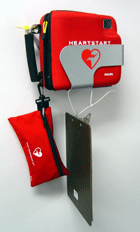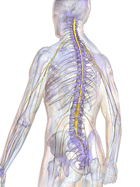 NRx is UHN's monthly research e-newsletter. Through NRx you can read about ongoing research at our five research institutes, the Princess Margaret Cancer Centre, the Toronto General Research Institute (TGRI), the Toronto Western Research Institute (TWRI), the Toronto Rehabilitation Institute (TRI) and the Techna Institute (Techna).
NRx is UHN's monthly research e-newsletter. Through NRx you can read about ongoing research at our five research institutes, the Princess Margaret Cancer Centre, the Toronto General Research Institute (TGRI), the Toronto Western Research Institute (TWRI), the Toronto Rehabilitation Institute (TRI) and the Techna Institute (Techna).
In this issue you can read about:
- Factors that prevent lung cancer survivors from quitting smoking
- A hormone that lowers blood sugar levels
- A muscle relaxant that improves survival after cardiac arrest
- Stem cells and nanomaterials to treat spinal cord injury
- Funding success for UHN researchers
- The launch of UHN’s new Biospecimen Database
We hope that you will find NRx informative. If you have feedback or questions, please contact www@uhnresearch.ca.
Christopher J. Paige, PhD, FCAHS
Vice President, Research
University Health Network

One’s ability to quit smoking can be influenced by nicotine dependence, social support and exposure to second-hand smoke.
While it has been shown that the ability to quit smoking is strongly influenced by social pressures, it is unclear if this is true for those recently diagnosed with lung cancer. These people must cope with the added stress and fear from learning of their condition.
A recent study, co-led by Princess Margaret Cancer Centre Scientist Dr. Geoffrey Liu and Affiliate Scientist Dr. Wei Xu, enrolled lung cancer patients that were smokers at time of diagnosis with lung cancer. Using patient questionnaires, Drs. Liu and Xu explored whether exposure to second-hand smoke influenced their ability to quit. Results showed that second-hand smoke—originating either at home, or from a spouse or friends who smoke—made it less likely that the patient would quit. Furthermore, the most powerful effect was exerted by second-hand smoke originating in the home and from a spouse that smokes.
Dr. Liu elaborates, "Those who continue to smoke after being diagnosed with lung cancer suffer worse prognoses, increased chance of cancer recurrence and other complications. Thus, it is paramount that physicians begin to consider psychosocial factors, such as those explored in the current study, on cessation of smoking with the aim of developing new strategies to improve outcomes."
This work was supported by the Alan B. Brown Chair in Molecular Genomics, the Cancer Care Ontario Chair in Experimental Therapeutics and Population Studies, the Posluns Family Foundation, the Lusi Wong Early Detection of Lung Cancer Program, the Scott Taylor Chair in Lung Cancer Research, the OSI Pharmaceuticals Foundation Chair in New Cancer Drug Development, the Princess Margaret Cancer Foundation and the COMBIEL Training Program.
Second-hand smoke as a predictor of smoking cessation among lung cancer survivors. Eng L, Su J, Qiu X, Palepu PR, Hon H, Fadhel E, Harland L, La Delfa A, Habbous S, Kashigar A, Cuffe S, Shepherd FA, Leighl NB, Pierre AF, Selby P, Goldstein DP, Xu W, Liu G. Journal of Clinical Oncology. 2014 January 13. [Pubmed abstract]

According to the World Health Organization, 347 million people worldwide have diabetes.
The sugar glucose is an important source of energy for all cells in the body and in particular those in the muscles and the brain. The concentration of glucose circulating in the blood is tightly controlled by several hormones, ensuring that blood sugar levels remain within a healthy range. Abnormally high blood sugar levels, sustained for longer periods of time, can damage tissues and are a defining symptom of diabetes. TGRI Senior Scientist Dr. Tony Lam and his team, including lead author Brittany Rasmussen, discovered that the hormone leptin acts in the gut to reduce blood sugar levels.
Leptin is primarily secreted by fat cells, circulates in the blood and activates cells in the brain to lower blood sugar levels. Using an experimental model of diabetes, Dr. Lam and his team demonstrated that leptin also activates cells in a particular region of the gut—a segment of the intestine called the jejunum—to lower blood sugar. Moreover, the team showed that leptin action in the gut contributes to the glucose-lowering and anti-diabetic effect of duodenal-jejunal bypass (DJB), a surgical procedure that alters the architecture of the gut. DJB has been documented to lower blood sugar levels in people with type 2 diabetes and obesity
Based on this discovery, leptin’s activity in the gut represents a viable new therapeutic target to lower blood sugar levels in diabetes.
This work was supported by the Canadian Institutes of Health Research and the Toronto General & Western Hospital Foundation. T. Lam is a Tier 2 Canada Research Chair in Obesity and holds the John Kitson McIvor (1915-1942) Endowed Chair in Diabetes Research. B. Rasmussen is supported by the CIHR Doctoral Vanier Canada Scholarship.
Jejunal leptin-PI3K signaling lowers glucose production. Rasmussen BA, Breen DM, Duca FA, Côté CD, Zadeh Tahmasebi M, Filippi BM, Lam TK. Cell Metabolism. 2014 January 7. [Pubmed abstract]

An Automated External Defibrillator (AED, as pictured above) is a portable device that enables bystanders to deliver the electric shocks needed to restart a person’s heart.
Cardiac arrest occurs when the heart suddenly stops beating and pumping oxygenated blood throughout the body. To restart the heart, cardiopulmonary resuscitation (CPR) followed by defibrillation—a process in which an electronic device gives an electric shock to the heart—needs to be administered immediately to minimize permanent damage and prevent death. TGRI Senior Scientist Dr. Kumaraswamy Nanthakumar recently published a study showing that CPR and defibrillation are more effective in treating cardiac arrest and promoting survival when they are administered in combination with a muscle relaxant known as dantrolene.
In most instances, cardiac arrest is preceded by an electrical malfunction of the heart, which causes it to beat erratically and pump blood ineffectively—an event known as ventricular fibrillation (VF). Dr. Nanthakumar and his team showed that the administration of dantrolene during CPR in models of VF-induced cardiac arrest resulted in a return-to-normal beating and pumping in a higher proportion of hearts. This effect was achieved by defibrillating the heart for shorter periods of time. Moreover, they demonstrated that dantrolene-treated hearts are more resistant to VF.
"Dantrolene may prove to be a useful complementary treatment for the management of sudden cardiac arrest due to VF," says Dr. Nanthakumar.
This work was supported by the Canadian Institutes of Health Research and the Toronto General & Western Hospital Foundation.
Dantrolene improves survival following ventricular fibrillation by mitigating impaired calcium handling in animal models. Zamiri N, Massé S, Ramadeen A, Kusha M, Hu X, Azam MA, Liu J, Lai PF, Vigmond EJ, Boyle PM, Behradfar E, Al-Hesayen A, Waxman MB, Backx P, Dorian P, Nanthakumar K. Circulation. 2014 January 8. [Pubmed abstract]

Patients with injuries to the spinal cord have more severe disabilities resulting in poor quality of life.
Stem cells have shown some promise in treating spinal cord injuries (SCIs) due to their ability to repair neural tissues; however, effective stem cell-based therapies for SCI have yet to be developed. This is because SCIs often result in a significant loss of neural tissue accompanied by the formation of cavities and scars that create an environment that prevents neural tissue repair.
New research from TWRI Senior Scientist Dr. Michael Fehlings has been exploring ways to enhance the therapeutic efficacy of stem cells by using three-dimensional structures known as nanofibers. When injected into the site of injury, the fibers are able to reduce the amount of inflammation at the site of SCI and preserve the neurons. Moreover, treatment with nanofibers and stem cells is more effective at promoting recovery from SCI than using stem cells alone.
As Dr. Fehlings explains, "Our findings demonstrate that using nanofibers may significantly improve the ability of stem cells to promote spinal cord repair and forms a basis for further research on using this strategy for treating SCI."
This work was supported by the Canadian Institutes of Health Research, the Krembil Family Foundation, the Toronto General & Western Hospital Foundation, the Gerald and Tootsie Halbert Chair in Neural Repair and Regeneration, and Phillip and Peggy DeZwirek.
Synergistic effects of self-assembling peptide and neural stem/progenitor cells to promote tissue repair and forelimb functional recovery in cervical spinal cord injury. Iwasaki M, Wilcox JT, Nishimura Y, Zweckberger K, Suzuki H, Wang J, Liu Y, Karadimas SK, Fehlings MG. Biomaterials. 2014 January 7. [Pubmed abstract]

Dr. Valerie Wallace was one of nine UHN scientists awarded CFI funding. Her research program will develop new treatments for retinal diseases.
New funding announced by the Canada Foundation for Innovation (CFI) will help create and expand research facilities and programs in cancer, spinal cord injury, diabetes, cardiovascular, neurodegenerative and retinal diseases at UHN.
Nine teams led by UHN’s Drs. Peter Backx, Michael Fehlings, Housheng Hansen He, David Jaffray, Lakshmi Kotra, Tony Lam, Trevor Pugh, Valerie Wallace and Donald Weaver received $4.8M through CFI’s John R. Evans Leaders Fund competition, which awarded a total of $48.4M to 251 projects across Canada.
This investment through this federal agency, with contributions from the private sector and UHN Foundations, will allow UHN to develop state-of-the-art facilities and purchase new equipment to advance research programs.

(L-R) Terry Michaelson, Dr. Christopher Paige, Dr. Sylvia Asa and Dr. Michael Roehrl celebrate the launch of the caTissueSuite/BDF project by making new connections.
On December 20th, 2013, an event was held to launch caTissueSuite—a new database that gives researchers access to a wealth of information on patient tissue samples collected and analyzed across UHN’s research labs. Speakers at the event included Dr. Christopher Paige, Vice President, Research; Terry Michaelson, I.T. Development Team Leader of the caTissueSuite/Biospecimen Data Federation (BDF) project; and Dr. Michael Roehrl, Director of the UHN Program in BioSpecimen Sciences (BSP) and Scientist at the Princess Margaret Cancer Centre.
The caTissueSuite/BDF project links research and clinical data with biospecimens and gives researchers access to more data associated with biospecimens, such as a patient's medical and treatment history; pathology diagnoses and reports; and details related to patient research consent. The caTissueSuite is designed to be flexible, comprehensive and practical, to encourage all UHN clinicians to migrate their biospecimen and related clinical data to the new system. Given the challenge of federating or "making connections" between the various databases, the BDF and BSP teams worked closely with many others at UHN, including RIS, SIMS and the Department of Pathology, to make this cutting-edge development a success. The caTissueSuite/BDF project is a unique scientific asset for UHN and a component of a larger research initiative—the Advanced Therapeutic Research Platform—funded by the Canada Foundation for Innovation.
 UHN’s
UHN’s  Princess Margaret Cancer Centre Senior Scientist Dr.
Princess Margaret Cancer Centre Senior Scientist Dr.